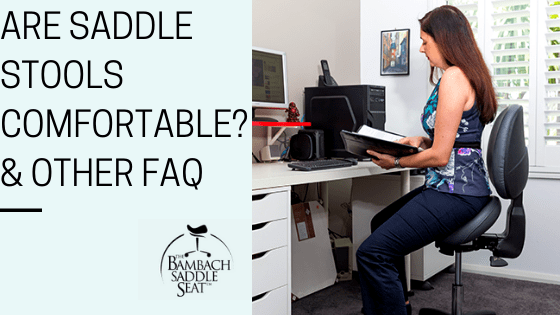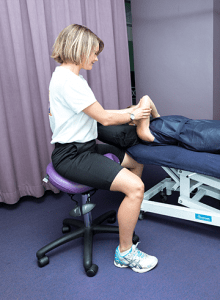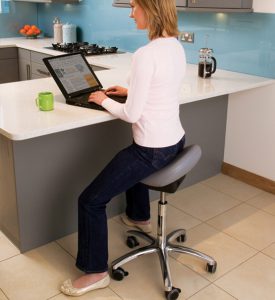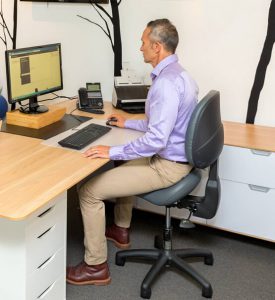
The Bambach Saddle Seat was the first of its kind in the world, and experts agree that it continues to lead the way in seating practice today. The Bambach is customised specifically for the needs of our customers, made to support your body, health and profession. Guaranteed for quality assurance, our range of saddle stools are ergonomically sound, tough, durable and safe. With or without a back, the Bambach range provides the right seat for any environment or purpose.
This month, we answer some frequently answered questions about the Bambach Saddle Seat:
Are saddle seats good for your back?
Bambach Saddle Seats support and encourage correct seating posture, making it a sound ergonomic seating solution for both children and adults. If you suffer from pain in your back, neck or upper limbs, then you could benefit from switching to a saddle seat. Our saddle seats are ideal for people whose work requires frequent reaching, varying work heights, close and accurate task work, long periods of standing, or has their work spread over a large area. A saddle seat will give you perfect posture along with the ability to use your hands for task work, and is suitable for a wide range of professionals including dentists, surgeons, lab workers, hairdressers, artists, therapists, veterinarians and teachers.
Are saddle stools comfortable?
Our customers find our saddle stools very comfortable, because of the way the Bambach helps improve posture, and minimises back and upper body pain. If you have been sitting with poor posture for many years, your body will need time to adjust, and it may take a few weeks to get used to your new saddle stool. We recommend an adjustment period of two weeks, using the saddle chair no more than one hour a day, and alternating between the Bambach and a flat seat. Explore all seat tilt and height variations to find what suits you, and consider investing in the sheepskin seat cover, which will both soften the seat and widen the support surface. You may feel tight in the hips and thighs at first, but these muscles and ligaments will stretch out and relax as your body adjusts. We also recommend not using the backrest of your saddle stool for the first few weeks, in order to help you adjust to your Bambach.
How do you sit on a saddle stool?
Bambach Saddle Seats differ from conventional seating in several ways. On a saddle stool, you sit higher than in a standard office chair, with your knee joints at a 45 degree angle. This ensures that your pelvis is supported in a neutral upright position. You may need to raise your computer screen or office desk to benefit from your saddle chair. If you usually work standing or on a high drafting stool, you can use your Bambach with a foot ring. If your work height is lower than recommended, you may need to tuck your feet under your saddle stool. As long as the knees are positioned lower than the hips, the benefits of using a saddle seat will still be achieved. To learn more, see our previous blog post on the benefits of using an ergonomic office chair.
How can I sit without back support?
The groundbreaking design of the Bambach Saddle Seat allows our customers to sit supported in comfort without back support. Unlike traditional ‘ergonomic’ chairs, which supports the lumbar curve by pushing into your back, the saddle seat supports the lumbar curve through the open hip angle and straddle posture. This position rotates the pelvis upright, keeping the spinal column in its neutral curves, opening up the chest and abdomen to allow full function of the lungs, and assisting in blood and lymphatic circulation. The active position of the saddle chair will also help enhance your muscle tone. Although you should not need a backrest for most upright and forward work, you can choose a Bambach with a backrest to use as a rest point while you think, listen or talk.
Are kneeling chairs bad for you?
Alternative ergonomic seating, including kneeling chairs and bicycle seats, do not support as many correct postures as the Bambach Saddle Seat. A kneeling chair puts sustained pressure on the knees, and locks your feet in underneath you. Getting in and out of a kneeling chair is difficult as your feet can become entangled in the kneeling pad. Similarly, bicycle seats can be uncomfortable over a long period and do not provide adequate stability. However, using a saddle seat puts no pressure on the knees, leaves your feet free to operate equipment or move around your work area, and supports and stabilises your body with its high, saddle posture. The hip joints rest in a relaxed, open position, and the spine is in perfect balance. The unique seat contour of the saddle chair will ensure that you bend forward from the hips, not from your back, creating the ideal sitting posture.
Are there different saddle stool sizes?
The Bambach range is available in four different saddle stool sizes, to fit everyone from small children to large adults. The Executive size seat is our most male-friendly seat, which is more anatomically comfortable for some men. To ensure that you benefit from your Bambach Saddle Seat, make sure that your clothing does not interfere with your hip abduction (leg spread). It is your hip abduction that stabilizes the pelvis and allows the spine to rest in a natural posture, ensuring your hip joints are in their ideal alignment in their sockets. As hip abduction decreases, the spine becomes less stable, the pelvis tilts backwards and the hip joints move out of ideal close contact. To benefit from your saddle stool, it is best to wear loose trousers or a wide skirt. For more tips on choosing the best saddle chair for you, see our helpful video guide.
The Bambach is the original saddle seat, designed and manufactured in Australia by occupational therapist Mary Gale. Bambach chairs are tested by AFRDI to the highest standards and are recommended by health professionals worldwide. To find the best Bambach seating solution for you, use our online seat calculator to choose a chair model or Contact Us today.




